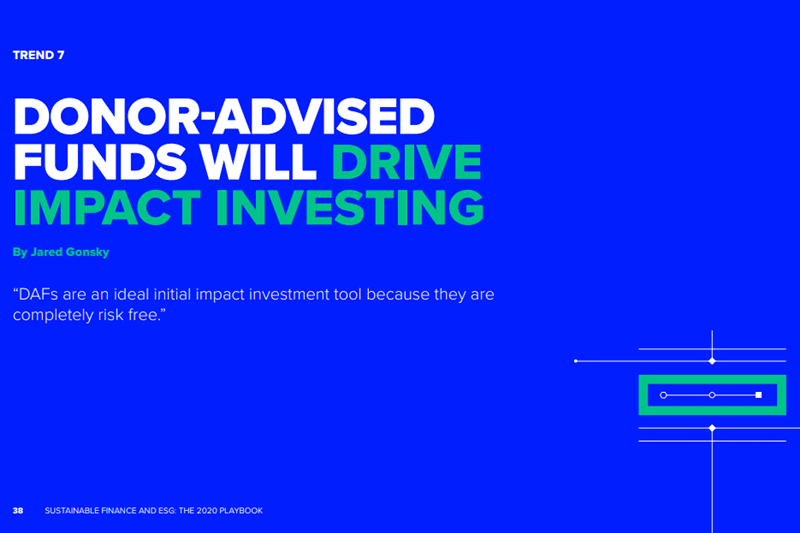The LOHAS Advisors team was recently asked to share its expertise on Donor-Advised Funds and hot impact investing trends for a Refinitiv E-Book entitled Sustainable Finance and ESG: The 2020 Playbook. You can view the full E-Book here. Below is our contribution on Donor-Advised Funds.
Donor-Advised Funds are skyrocketing in popularity
Donor-Advised Funds (DAFs) are philanthropic and social impact investment tools that allow donors (individuals, families, corporations, etc.) to fund special accounts through DAF “sponsor” organizations. Donors receive immediate U.S. income tax deductions and maintain allocation privileges over the fund’s distribution.
While adoption of DAFs started slowly, capital is aggregating quickly, and DAFs have become a leading tool for donation and investment in the social and environmental impact sectors. According to the 2019 Donor-Advised Fund Report of the National Philanthropic Trust (NPT), assets in DAFs now total over $121 billion, with over $37 billion in new DAF contributions in 2018 alone.
Notably, there are now over 728,000 individual DAFs across the U.S., and the number of DAFs grew an astonishing 55% from 2017 to 2018. Contributions to DAFs have also continued to increase as a percent of total individual giving over the last decade.

Source: 2019 Donor-Advised Fund Report, National Philanthropic Trust
What effect can DAFs have on impact investing?
DAFs have typically been used for charitable donations and philanthropic grant-making. However, astute donors have started to recognize that by directly investing DAF capital in for-profit companies or funds, they can become extraordinary vehicles for achieving meaningful social and environmental impact.
In fact, if managed correctly, DAFs can become impact investing venture capital funds for donors. They can either servce as their first steps into the impact investing world or enhance the work they have already been doing with their traditional portfolios.
DAFs are an ideal initial impact investment tool because they are completely risk-free – the funds have already been donated, so no financial returns to the donor are expected. However, investments from a DAF that generate financial returns can flow back into the DAF. That means the capital is then available for the donor to direct towards the next socially or environmentally impactful venture (as with a traditional investment portfolio).
There are a variety of ways in which the capital held in DAFs can be invested to further one’s impact goals. For example, they can be the ideal capital to use for early stage or higher risk investments (that may not align well with the donor’s main portfolio). Similarly, corporate DAFs provide a simple mechanism for making strategic investments in missionaligned companies that complement the corporation’s business model or further a stated impact goal.
“DAFs are an ideal initial impact investment tool because they are completely risk free.”
Currently, most DAF sponsors do not allow DAFs to be used as (for-profit) impact investing mechanisms, and those that do often offer only a limited selection of investment options for donors.
However, some DAF sponsors are showing greater flexibility, and DAFs can typically be transferred to other sponsors that better support donors’ impact investing goals. Notably, DAF funds can even be used to pay advisors to help transfer DAFs (when needed), analyze investment opportunities and deploy DAF capital as effectively as possible towards the causes that the donor is most passionate about.
Our top takeaways:
- Donor-Advised Funds (DAFs) have become viable tools for investment in the social and environmental impact sectors.
- DAFs are becoming increasingly popular, with the number of funds growing 55% between 2017 and 2018.
- DAFs can provide capital to use for early stage or higher risk impact investments.





